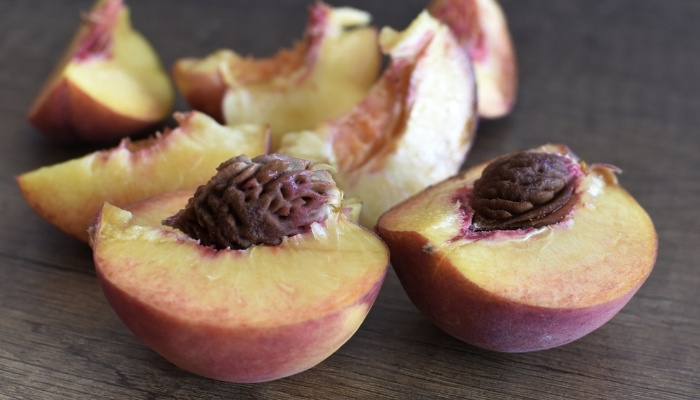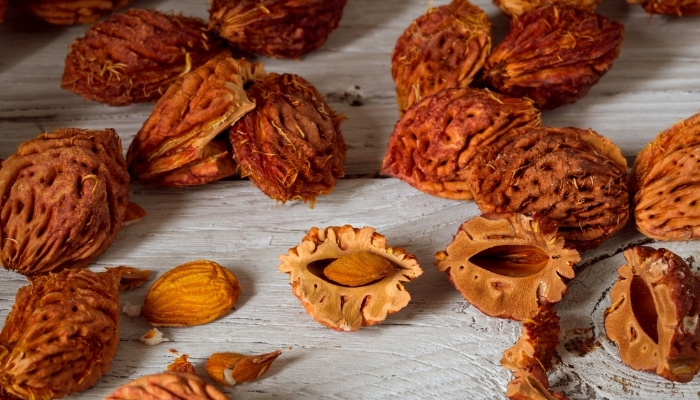If you decide to plant the pit of a peach, or any other fruit that you like, there is a possibility that it will grow into a tree and produce more tasty fruits.
Luckily, with peaches, this is possible. You’ll often get an exact replica of the parent tree when you plant the peach seed.
However, to get to that point, you have to successfully germinate the pit first. Just planting it in the soil generally will not work. Cold stratification is essential for speeding up the germination of the seed within the pit.
The following guide walks you through the process of germinating peach seeds step by step.
It’s no secret that cultivating peach trees can be a challenge. That’s why I crafted the ultimate guide to Peach Tree Care and Maintenance. It’s a comprehensive resource packed with all the crucial details and expert advice!
Supplies Needed
- Peach seed
- Bleach
- Fungicide
- Planting container
- Potting mix
- Toothbrush
- Fridge
- Nutcracker
1. Select the Right Variety
Peaches come in different varieties including Redhaven peach, donut peach, and yellow peach.
But just because a certain peach variety is in the supermarket, that doesn’t mean that you can grow it in your garden or yard. You have to find the right peach variety for your particular Hardiness Zone.
If you live in Zone 4, then choose a cool-temperature variety such as Hale. Madison is suitable for Zone 5, while Saturn grows well in Zone 6.
For warmer zones starting with Zone 7, you can grow the Contender variety without any issues. Frost peach is a variety that needs plenty of sunlight and the warm temperatures of Zone 8. Zone 9 is good for Topaz while Florida Beauty is ideal for Zone 10.
2. Extract the Pit
The easiest way to extract the pit is to eat the peach. That way you can decide if you want to have this variety in your garden or not. Another way to extract the pit is to slice the peach in half with a knife. Then use the tip of the blade to dislodge the pit and pull it out.
3. Clean the Pit
The pit will usually have bits of flesh on it. These bits will rot quickly and attract bugs. Use a toothbrush to remove all traces of flesh on the pit. Then put it under running water to make sure it’s thoroughly clean.
Add 1 tablespoon of bleach to 1 liter of water, and soak the pit in it for an hour to get rid of germs. Finally, spray it with a fungicide to prevent mold buildup, and pat the pit dry with a kitchen towel. Then leave it to dry in a cool and dry place all night.
4. Remove the Outer Shell
This step is optional, but it ensures fast germination as it allows moisture into the seed directly. You can use a pair of pliers or a nutcracker to crack the shell open and extract the seed inside.
Be careful not to damage or scratch the seed while cracking the shell. If you’re not sure that you can crack the outer shell without damaging the seed inside, leave the shell intact and skip this step.
5. Place the Pit in the Fridge
Cold stratification is crucial for the germination of the pit. Start this process 4 months before the last frost. Wrap the pit in a moist paper towel, place it in a Ziploc plastic bag, and keep it in the fridge.
To be on the safe side, place more than one pit in the bag. This will allow you to plant more than one sprout and keep the healthy and successful one.
Keep the pits in the fridge for 8 weeks. Check on them regularly to make sure there’s no mold buildup on the pits, and sprinkle some water on the paper towel to keep it moist. After about 8 weeks, the pits will germinate.
6. Plant the Sprout
Fill a medium-sized container with a potting mix and make a hole in the middle for the peach sprout. If you’re planting more than one sprout, prepare a pot for each one. Plant the sprout 4 inches deep, and cover it with soil. Water the pot to get it moist but not wet.
7. Harden the Seedling
Keep the pot indoors until the weather warms up. Once the threat of the last frost is over, bring the seedling outside. Place it in a sunny spot away from cold winds for one hour then take it back inside.
This will harden the seedling and prevent transplant shock. Increase the outdoor time for the peach seedling gradually.
8. Transplant the Seedling
When the soil is workable and the seedling is hardened, choose a spot facing the west or south that gets 6 to 8 hours a day of full sun. Select the two strongest peach seedlings, and plant them 5 feet apart.
After 6 months, you can pull out one of them and keep the peach tree that’s growing successfully if desired.

Common Questions:
Can You Germinate Peach Seeds in Water?
Peach seeds need chill hours to trigger the process of germination. This mimics the winter months when the pits are lying in cold soil. This is why to germinate the pits, you need to keep them in the fridge for about 8 weeks.
If you try to germinate the seeds in water, the seeds would rot and not germinate. You need both cold stratification and a potting mix to successfully sprout the seeds.
How Long Are Stored Peach Seeds Viable For?
The best way to ensure that your peach seeds will germinate is to plant them within the first year. After the first year, most seeds lose the ability to germinate.
Storage conditions also affect the viability of the seeds. Damp conditions trigger mold buildup that can damage the seeds inside the pit.
Does It Matter Which Peach Variety I Choose?
It matters a lot which peach variety you choose. For one thing, the taste and flavors matter, but most importantly, not all peach varieties are suitable for your Growing Zone.
In general, peaches can grow in Zones 4 to 10, but the peach varieties vary wildly in their ability to handle the different weather conditions in each one of those zones.
I recommend choosing a variety that grows locally. Check the nursery near you for the best peach variety to grow.
Can You Plant Peach Seeds Directly in Garden Soil?
If you plant peach seeds directly in the garden soil in the summertime, you will be skipping the cold stratification phase, which is crucial for the germination of the seed. That means the seed may not germinate in the soil even if the growing conditions are ideal.
Generally, you need to keep the pit in the fridge for 8 weeks to sprout, plant the sprout in a pot, and keep it indoors for another 8 weeks before you transplant it into the garden.
However, if you plant a peach seed in late fall, nature will take care of the cold stratification for you, and you may see a sprout emerge in the spring.
What’s the Best Time of Year To Germinate Peach Seeds?
You should start germinating the peach seed about 4 months before the last frost. Cold stratification takes about 2 months before the seed germinates. Then you need another 2 months of growing the sprout in a pot indoors to protect it against the elements.
Depending on your microclimate, either December or January is the best time of year to germinate peach seeds.
Can Peach Seeds Germinate Without Cold Stratification?
That’s highly unlikely. Cold stratification mimics the conditions of the soil during the winter months. The soil is slightly moist and the temperature is cold. Those two factors are needed for the successful germination of the peach seeds.

Tips for Germination Success
Since peach pits need cold stratification, germination isn’t always guaranteed. However, the following tips will help you get your pits to sprout successfully.
- Crack the shell of the pit before placing it in the fridge. This saves the seed the effort of cracking through the shell. The shell is only for protection and doesn’t contain any nutrients that the seed needs to germinate.
- Use a fungicide to eliminate all fungi that could build up on the shell and prevent it from germinating.
- Choose a peach variety that grows locally in your area. This not only will ensure a high germination rate but also the success of the seedling in the garden.
- Try to germinate fresh peach seeds as opposed to stored ones. Old pits have a low germination rate, especially if they have been stored in bad conditions.
- Cold stratification is necessary for the germination of the pits. Don’t try to skip this step or fast-track it. The pit has to get 8 weeks of cold temperatures to trigger the germination process.
- Always try to germinate more than one pit. When they sprout, plant each one in its own pot. That way you can select the strongest and healthiest seedling to transplant into the garden.
Conclusion
It’s easy to germinate a peach seed as long as you expose it to 8 weeks of cold temperatures in the fridge.
The peach sprout needs another 8 weeks of growing indoors before it’s strong enough to be transplanted outdoors. Harden the seedling by taking it outdoors for an hour every day before transplanting.
Ready to keep learning? Be sure to explore these interesting and informative guides next:
- 15 Top Companion Plants for Peach Trees (& 5 To Avoid)
- Growing Peach Trees in a Container: Complete Growing Guide
